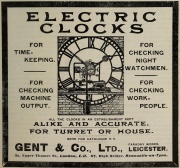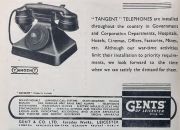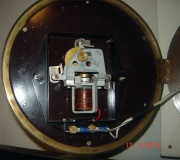Gent and Co

of Faraday Works, Leicester. Telephone: 24151/2/3, Telegraphic Address: "Gents, Leicester"
1872 John Thomas Gent started the business after serving an apprenticeship in Halifax.
It is said that G. T. Gent and Co were one of the first to produce electric bells in the UK. During the first years Gent was interested in developing electrical equipment, including telephones, fire alarms, electric lightning and other devices.
1884 I. H. Parsons was apprenticed to Mr Gent, later followed by A. W. Stavely. Mr Gent retired from Gent and Co that year, leaving Parsons and Stavely as joint partners.
1903 The firm was registered as a limited company known as Gent and Co. Shortly after that A. E. J Ball joined the company and they started to produce an electric clock system, known eventually as the "Pul-syn-etic".
1904 Offered water-tight contacts for use with water-level alarms.
1907 The firm produced the famous Waiting Train system.
1937 Listed Exhibitor - British Industries Fair. "Pul-Syn-Etic" Electric Impulse Clocks, including Turret and Marine. Synchronous Clocks. "Tangent" Metal-clad Bells, Relays, Telephones, Mining and Industrial. Electro-Motor Syrens, Liquid Level Indicators and Recorders. Staff Locators. Fire Alarms. Luminous Call Systems. (Stand No. Cb.606) [1]
1937 Manufacturing electrical engineers. "Pul-syn-etic" Electric Impulse Clocks. "Tangent" Electrical Apparatus. [2]
1961 Electrical and horological engineers, manufacturing bells, buzzers, relays, indicators, staff locators, luminous call systems, certified mining equipment, transformers, electric impulse and synchronous clocks, watchman's clocks, fire and burglar alarms, telephones, process timers, and liquid level control apparatus. 400 employees. [3]
1975 Chloride Group made an agreed bid for Gent, a private company; formation of Chloride Gent
1977 Acquired Agro Electrical Co
1982 MK Electric acquired Chloride Gent, maker of fire alarms, commercial and industrial clocks and call systems[4]
1982 Became Gent Ltd
1994 Became Caradon Gent Ltd
2000 Caradon sold many of its activities. The company was renamed Gent Ltd
See Also
Sources of Information
- ↑ 1937 The Aeroplane Directory of the Aviation and Allied Industries
- ↑ 1937 British Industries Fair Page 368
- ↑ 1961 Dun and Bradstreet KBE
- ↑ The Times, Jul 29, 1982

























